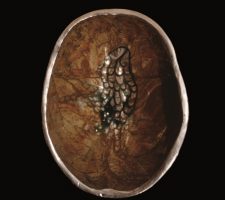Text: Anna Lena-Grau | Section: Articles by Artists
Abstract: In her exhibition Gespinste – Interweavings held in the anatomical collection in Erlangen, Anna Lena Grau juxtaposed selected scientific specimens with objects and pictures developed especially for her installation. For instance, she brings together an artistic procedure called the ‘lost-wax’ technique with a taxidermist’s production method to create anatomical models. Grau places specimens of the collection, which were produced for a scientific purpose, side by side with a cultic object in order to demonstrate the different ways of dealing with a dead body.
In 1754, the Anatomical Collections of the University of Erlangen-Nuremberg were established for the purpose of providing teaching material for classes held at the Anatomical Institute. In the meantime, the collection is also accessible to non-specialists twice a year. Yet, due to the extraction of the specimen from its original context and its solidification into an object, a layman will never be able to perceive a specimen with the rational logic that is appropriate to the observation of scientific models. The object thus takes on the appearance of a shadow of the living, reminding us of our own mortality in a disturbing yet monstrous way.
In a site-specific installation conceived for my exhibition Gespinste – Interweavings, I confronted selected specimens with objects and pictures specifically developed for the presentation, providing a stage for what might have remained concealed otherwise.
For the preparation of a metal cast, the wax placeholders of the sprues, which later allow for the inflow of the molten metal and its even distribution, are placed onto a wax form. Scientists producing anatomical preparations follow a similar approach when using veins and vessels of an organ as casting molds and reproducing these via the ‘lost-wax’ technique out of wax, synthetic material, and metal. For the group of works titled Galatea / Casting Tree 1–13, I combined technical applications of the lost-wax technique with the method used for creating models in the field of anatomical preparation. In the course of this, I usually melded the technical sprues with organic entities rendering fully functional wax casting trees.
Due to fact that these objects can be used as casting molds the wax objects refer to a future event, a painting process is documented in the loop of the slide projection Gespinst – Interweaving. Here, 81 photographs depicting a continuous painting that I carried out on the inside of an empty, silver-lined skull cup are to be seen. In the course of the painting process, I place accents on the bone relief with its fine structures, lines, and veins, interpreting and reacting to the given topology. In this open process, new motifs and constellations continue to develop inside the skull.

In contrast to the specimens of the collection in Erlangen that were produced for scientific reasons, the skull cup − a so-called Kapala − is a cultic object that came into my possession. From the 7th and 8th century onwards, the Kapala was used during Tantric rituals, especially in Tibet and India. It traditionally served as a begging bowl, used for consumption of food and drinks, and is still referred to as an ‘inner offering bowl’ today.
The hygienic requirements of anatomical preparation and the spiritual rules of the Tantrist respectively form the cultural, religious, and ethical framework for handling the dead body. The fragmentation of a body, the isolation of single organs, and their transformation into a cultic object represent an act of transgression and a state of exception, which are strictly regulated by necessity.
Working artistically with both, the scientific and the ritual object appears to result in a ‘counter-transgression’, leading to the concept of a historically contingent and boundless body.
Anna Lena Grau: Gespinst – Interweaving (2013). The slide projection depicts 81 individual moments of painting in the inside of a Kapala. Photos: Anna Lena Grau.
Anna Lena Grau: Galatea / Casting trees 1–3 (2010). bronze.
The funnels, sprues, and bronze pipes served as material feed lines for three picture moldings.
Photograph by Daniel Lang
Anna Lena Grau: Showcase (2010). Anatomical Collection Erlangen.
Photograph by Anna Lena Grau.
Corroded specimen of a kidney, 1990s, plastic, holdings of the collection.
One kidney served as a lost-wax mold for this three-colored plastic molding. In the finely ramified object the distribution of veins (blue), arteries (red) and the urinary system (yellow) becomes comprehensible.
Photograph by Daniel Lang.
Dry Specimens of Hearts, 2000s collection.
Donor hearts were used to produce the dry specimens. They were fixed in a mixture of formalin and alcohol and were later impregnated with polyethylene glycol. The specimens are used for demonstration purposes, for example at cardiologist conferences.
Photograph by Anna Lena Grau.
Enlarged Skull, probably late 19th century, collection.
A previously cleaned infant’s skull that was filled with peas and water via the foramen magnum. Due to the even radial pressure of the soaking peas the skull joints detached from the inside.
Photograph by Daniel Lang.
Skull bases, painted, probably 19th century, collection.
The bones of the left skull base were painted with different colors in order to highlight the joints. On the right skull base, thin blue lines were drawn to mark the distribution of the dural venous sinuses (venous channels).
Photograph by Anna Lena Grau.
Molding of a Renal Pelvis, probably 19th century, collection, metal alloy.
Two renal pelvises served as lost molds for small metal objects. At that, the ureters formed the sprues for a liquid copper-lead alloy.
Photograph by Anna Lena Grau.
Martin Van Den Bogaert Desjardins (1640–94): bronze cast.
Illustration from the book Marie-Thérèse Baudry: La Sculpture. Méthode et Vocabulaire. In cooperation with Dominique Bozo, André Chastel and Jacques Thirion. Paris 1978, p. 252.
The bronze sprues and pipes of the statuette were preserved to visualize the metal’s way during the molding process. Following this example, moldings of the Equestrian statues of Ludwig XIV (Joseph Roger) and Frederick V (Jacques Saly) were planned and implemented.
Translation Norah Lewerentz.
More information www.annalenagrau.com
How to cite this article
Anna Lena Grau (2016): Anna Lena Grau: Gespinste – Interweavings. w/k–Between Science & Art Journal. https://doi.org/10.55597/e1570





















Be First to Comment